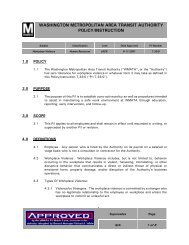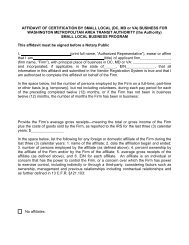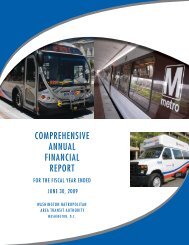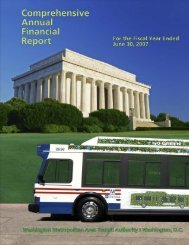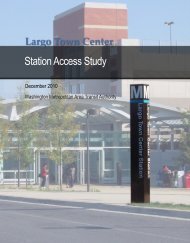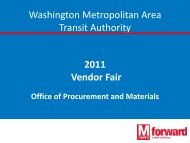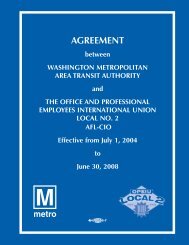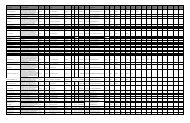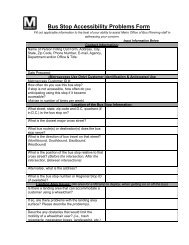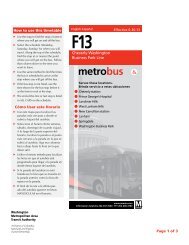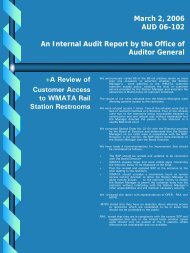Naylor Road Metro Station Area Access and Capacity - WMATA.com.
Naylor Road Metro Station Area Access and Capacity - WMATA.com.
Naylor Road Metro Station Area Access and Capacity - WMATA.com.
You also want an ePaper? Increase the reach of your titles
YUMPU automatically turns print PDFs into web optimized ePapers that Google loves.
Table A-6: Average Peak Hour Bus Passenger Loads at <strong>Naylor</strong> <strong>Road</strong> <strong>Station</strong><br />
(Year 2040)<br />
(J) Average<br />
Peak Hour<br />
Passenger Load<br />
per Bus<br />
(K) 2012<br />
Average Peak<br />
Hour Passenger<br />
Load<br />
(L) 2012-<br />
2040 Percent<br />
Increase in Bus<br />
Passengers<br />
(M) 2040<br />
Average Peak<br />
Hour Passenger<br />
Load<br />
Route<br />
<strong>Metro</strong>bus<br />
M2 35 105 35% 142<br />
F14 35 70 35% 95<br />
H11/12/13 35 140 35% 189<br />
C12/C14 35 84 35% 113<br />
36 35 140 35% 189<br />
39 35 140 35% 189<br />
34 35 140 35% 189<br />
TheBus<br />
32 35 70 35% 95<br />
J. Assumed average peak hour passenger load per bus at <strong>Naylor</strong> <strong>Road</strong> <strong>Station</strong><br />
K. 2012 Average Peak Hour Passenger Load = B * J<br />
L. Percent increase in bus passengers taken from Table A-3 in Appendix 3<br />
M. 2040 Average Peak Hour Passenger Load = K * (1+L)<br />
Table A-7: Bus Bays Required (Year 2040)<br />
(N) Buses<br />
per Peak<br />
Hour<br />
(O) Peak<br />
Hour<br />
Headway<br />
(minutes)<br />
(P) Average<br />
Recovery<br />
Time<br />
(minutes)<br />
(Q) Average<br />
Total Time at<br />
Bay per Bus<br />
(minutes)<br />
(R) Bays<br />
Required<br />
Route<br />
<strong>Metro</strong>bus<br />
M2 4 15 3 4 0.5<br />
F14 3 20 5 6 0.5<br />
H11/12/13 5 12 6 7 0.9<br />
C12/C14 3 20 4 5 0.5<br />
36 5 12 9 10 1.2<br />
39 5 12 0 1 0.4<br />
34 5 12 5 6 0.8<br />
TheBus<br />
32 3 20 8 9 0.7<br />
Total 33 7.0<br />
N. Buses per Peak Hour in 2040 = M / 40 (Passenger capacity per bus) [results<br />
were rounded up to the nearest whole number]<br />
O. Peak Hour Headway = 60 / N<br />
Q. Average Total Time at Bay per Bus = One-minute dwell time + P<br />
R. Bays Required by 2040 = ((Q + E) * N) / 60<br />
40 passengers. While some routes<br />
may use articulated buses, using<br />
a 40-passenger-per-bus capacity<br />
provides a more conservative<br />
estimate. To estimate the number<br />
of bays required, the same<br />
methodology employed in Table<br />
A-4 is used in Table A-7. The same<br />
average recovery time from Table A-4<br />
is assumed in Table A-7. However, in<br />
practice several variables are factored<br />
into how much time is allotted per<br />
bus at a terminal stop (e.g. restroom<br />
or meal breaks, scheduling needs,<br />
etc.).<br />
Table A-8 reveals the final<br />
calculations of the analysis to<br />
estimate the bus bay utilization in<br />
2040. Calculations in Table A-8 are<br />
similar to those in Table A-5. Table<br />
A-8 proposes new bus bay route<br />
assignments for seven bays (six<br />
active bays <strong>and</strong> one drop-off bay)<br />
as calculated in Table A-7. Bus bay<br />
utilization in Table A-8 may be above<br />
100 percent, but actual utilization at<br />
these bays will likely be much lower<br />
provided that drivers use designated<br />
layover spaces.<br />
Table A-8: Bus Bay Utilization (Year 2040)<br />
Bus<br />
Bay<br />
(S) Buses<br />
per Peak<br />
Hour<br />
(T) Total<br />
Time at Bay<br />
(minutes)<br />
(U) Bay<br />
Utilization<br />
Route<br />
Provider<br />
M2/C12/C14 <strong>Metro</strong>bus A 7 59 98%<br />
F14/TB32 <strong>Metro</strong>bus, TheBus B 6 69 115%<br />
H11/12/13 <strong>Metro</strong>bus C 5 55 92%<br />
36 <strong>Metro</strong>bus D 5 70 117%<br />
39 <strong>Metro</strong>bus E 5 25 42%<br />
34 <strong>Metro</strong>bus F 5 50 83%<br />
Spare/Drop off - G - - -<br />
S. Buses per Peak Hour = ∑ N per bay<br />
T. Total Time at Bay = ∑ (N * (Q + E)) per bay<br />
U. Bay Utilization = T / 60<br />
<strong>Naylor</strong> <strong>Road</strong> <strong>Metro</strong> <strong>Station</strong> <strong>Area</strong> <strong>Access</strong> <strong>and</strong> <strong>Capacity</strong> Study | 82





